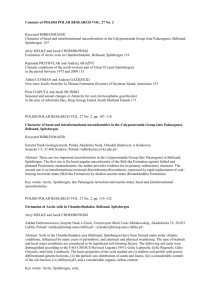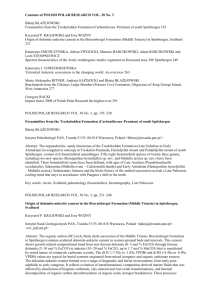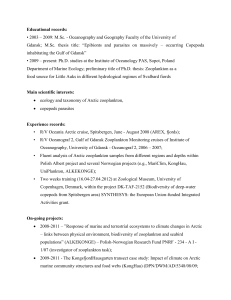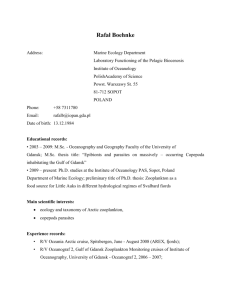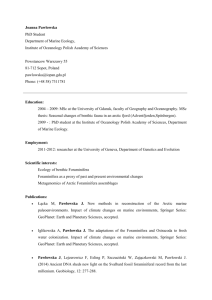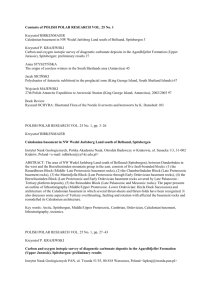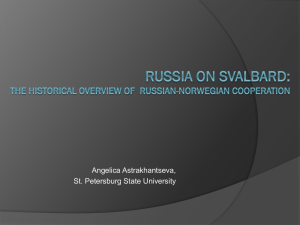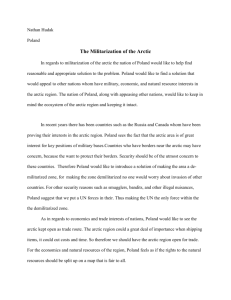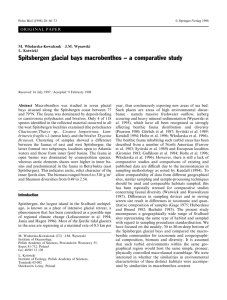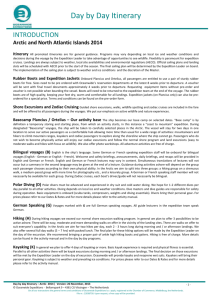POLISH POLAR RESEARCH VOL
advertisement
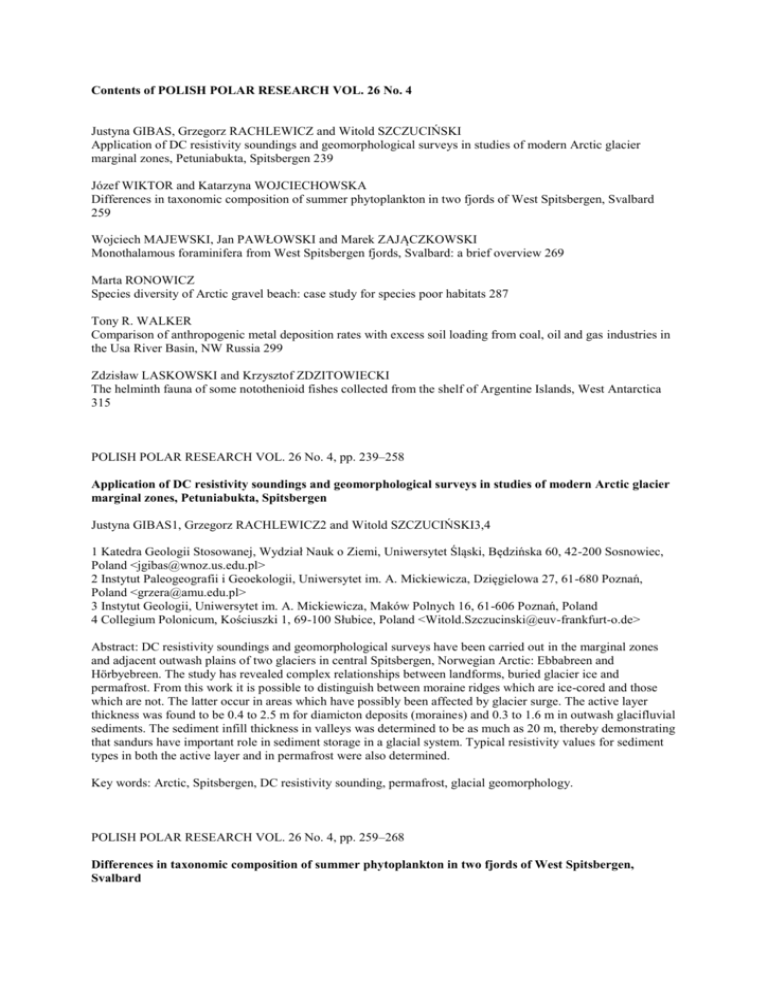
Contents of POLISH POLAR RESEARCH VOL. 26 No. 4 Justyna GIBAS, Grzegorz RACHLEWICZ and Witold SZCZUCIŃSKI Application of DC resistivity soundings and geomorphological surveys in studies of modern Arctic glacier marginal zones, Petuniabukta, Spitsbergen 239 Józef WIKTOR and Katarzyna WOJCIECHOWSKA Differences in taxonomic composition of summer phytoplankton in two fjords of West Spitsbergen, Svalbard 259 Wojciech MAJEWSKI, Jan PAWŁOWSKI and Marek ZAJĄCZKOWSKI Monothalamous foraminifera from West Spitsbergen fjords, Svalbard: a brief overview 269 Marta RONOWICZ Species diversity of Arctic gravel beach: case study for species poor habitats 287 Tony R. WALKER Comparison of anthropogenic metal deposition rates with excess soil loading from coal, oil and gas industries in the Usa River Basin, NW Russia 299 Zdzisław LASKOWSKI and Krzysztof ZDZITOWIECKI The helminth fauna of some notothenioid fishes collected from the shelf of Argentine Islands, West Antarctica 315 POLISH POLAR RESEARCH VOL. 26 No. 4, pp. 239–258 Application of DC resistivity soundings and geomorphological surveys in studies of modern Arctic glacier marginal zones, Petuniabukta, Spitsbergen Justyna GIBAS1, Grzegorz RACHLEWICZ2 and Witold SZCZUCIŃSKI3,4 1 Katedra Geologii Stosowanej, Wydział Nauk o Ziemi, Uniwersytet Śląski, Będzińska 60, 42-200 Sosnowiec, Poland <jgibas@wnoz.us.edu.pl> 2 Instytut Paleogeografii i Geoekologii, Uniwersytet im. A. Mickiewicza, Dzięgielowa 27, 61-680 Poznań, Poland <grzera@amu.edu.pl> 3 Instytut Geologii, Uniwersytet im. A. Mickiewicza, Maków Polnych 16, 61-606 Poznań, Poland 4 Collegium Polonicum, Kościuszki 1, 69-100 Słubice, Poland <Witold.Szczucinski@euv-frankfurt-o.de> Abstract: DC resistivity soundings and geomorphological surveys have been carried out in the marginal zones and adjacent outwash plains of two glaciers in central Spitsbergen, Norwegian Arctic: Ebbabreen and Hörbyebreen. The study has revealed complex relationships between landforms, buried glacier ice and permafrost. From this work it is possible to distinguish between moraine ridges which are ice-cored and those which are not. The latter occur in areas which have possibly been affected by glacier surge. The active layer thickness was found to be 0.4 to 2.5 m for diamicton deposits (moraines) and 0.3 to 1.6 m in outwash glacifluvial sediments. The sediment infill thickness in valleys was determined to be as much as 20 m, thereby demonstrating that sandurs have important role in sediment storage in a glacial system. Typical resistivity values for sediment types in both the active layer and in permafrost were also determined. Key words: Arctic, Spitsbergen, DC resistivity sounding, permafrost, glacial geomorphology. POLISH POLAR RESEARCH VOL. 26 No. 4, pp. 259–268 Differences in taxonomic composition of summer phytoplankton in two fjords of West Spitsbergen, Svalbard Józef WIKTOR and Katarzyna WOJCIECHOWSKA Instytut Oceanologii, Polska Akademia Nauk, Powstańców Warszawy 55, 81-712 Sopot, Poland <wiktor@iopan.gda.pl> <kasia_wojciechowska@hotmail.com> Abstract: Fjords of West Spitsbergen are very dynamic in terms of hydrology. Here we tested whether the qualitative analysis of the taxonomic composition of phytoplankton may be useful as a fast method to assess the origin of the waters and whether it can give any additional information to hydrological data. Phytoplankton samples were collected along transects in Hornsund and Kongsfjord. Among total of 109 taxa identified, only 49 were common in both fjords. The assemblages in Hornsund implied that inflow of the cold waters of the Sørkapp Current had occurred some time before samples collection, while in Kongsfjord the taxonomic composition was typical for the summer and did not show any recent, unusual hydrological phenomenon. Concluding, the method can be useful in the surveys in which hydrological data are collected infrequently. Key words: Arctic, Spitsbergen, summer phytoplankton, fjords, hydrology. POLISH POLAR RESEARCH VOL. 26 No. 4, pp. 269–285 Monothalamous foraminifera from West Spitsbergen fjords, Svalbard: a brief overview Wojciech MAJEWSKI1, Jan PAWŁOWSKI2 and Marek ZAJĄCZKOWSKI3 1Instytut Paleobiologii, Poska Akademia Nauk, Twarda 51/55, 00-818 Warszawa, Poland <wmaj@twarda.pan.pl> 2Department of Zoology and Animal Biology, University of Geneva, Sciences III, 30 Quai Ernest Ansermet, CH 1211 Genève 4, Switzerland <jan.pawlowski@zoo.unige.ch> 3Instytut Oceanologii, Polska Akademia Nauk, Powstańców Warszawy 55, 81-712 Sopot, Poland <trapper@iopan.gda.pl> Abstract: During the 2004 summer season, 14 sediment samples were collected in Kongsfjorden and Isfjorden, West Spitsbergen, from 6 down to 345 m water-depth (mwd). The samples yielded abundant assemblage of monothalamous foraminifera, belonging to almost 40 morphotypes. Our qualitative (>125 µm) and quantitative data (125–500 µm) allowed to distinguish three water-depth related assemblages in both Kongsfjorden and Adventfjorden (branch of Isfjorden), indicating that soft-walled monothalamous foraminifera show similar habitat gradation along fjord axis as calcareous and robust agglutinated taxa. Among the monothalamous foraminifera, the subtidal assemblage (6 mwd) was dominated by various unidentified allogromiids. The second, shallow-water assemblage (44–110 mwd) was dominated by Psammophaga sp. 1–3, Hippocrepinella crassa, Hippocrepinella cf. hirudinea, and large Gloiogullmia sp. 2. The deep-water (150–345 mwd) monothalamous assemblage was dominated by Psammophaga sp. 4, pear-shaped Hippocrepina sp., Hippocrepina indivisa, and long Cylindrogullmia sp. 2, as well as large agglutinated species Hyperammina subnodosa with attached Tholosina bulla, Hyperammina fragilis and Lagenammina sp. Key words: Arctic, Spitsbergen, Foraminifera, Recent. POLISH POLAR RESEARCH VOL. 26 No. 4, pp. 287–297 Species diversity of Arctic gravel beach: case study for species poor habitats Marta RONOWICZ Instytut Oceanologii, Polska Akademia Nauk, Powstańców Warszawy 55, 81-712 Sopot, Poland < martigor1@o2.pl> Abstract: Intertidal zone of four gravel beaches in Hornsund Fjord (West Spitsbergen) were investigated in order to study macrofaunal distribution and diversity in these poor habitats. A total of 12 macrofaunal taxa were found in the collected material. The most frequent and the most abundant taxon was Lumbricillus sp. (Oligochaeta). The next most numerous group were juvenile Gammarus spp. juv. The fauna included also polychaetes, molluscs and other crustaceans. The diversity measured with Shannon-Weaver index was low and varied from 0 to 1.4. The analysis revealed that there were no statistically important differences in macrofaunal distribution among stations in fjord. However there were significant differences among various tidal mark zones and high patchiness in animals abundance at each station. Also species composition, density and biomass were diversified along the tide level profile. Key words: Arctic, Spitsbergen, Hornsund Fjord, gravel beach, macrofauna, biodiversity. POLISH POLAR RESEARCH VOL. 26 No. 4, pp. 299–314 Comparison of anthropogenic metal deposition rates with excess soil loading from coal, oil and gas industries in the Usa River Basin, NW Russia Tony R. WALKER School of Biology, University of Nottingham, University Park, Nottingham, NG7 2RD, UK; present address: Department of Oceanography, Dalhousie University, Halifax, Nova Scotia, B3H 4J1, Canada <trwalker@dal.ca> Abstract: Trace metal composition of snowpack, snow-melt filter residues and top-soils were determined along transects through industrial towns in the Usa River Basin: Inta, Usinsk and Vorkuta. Elevated concentrations of deposition elements and pH in snow and soils associated with alkaline coal ash within 25–40 km of Vorkuta and Inta were found. Atmospheric deposition in the vicinity of Vorkuta and Inta, added significantly to the soil contaminant loading as a result of ash fallout. The element concentrations in soils within 20–30 km of Vorkuta do not reflect current deposition rates, but instead, reflect an historical pollution legacy, when coal mining activity peaked in the 1960s. There is little evidence of anthropogenic metal deposition around the gas and oil town of Usinsk. Key words: Russian Arctic, Usa River Basin, soil and snow chemistry, soil loading, coal combustion, ash fallout POLISH POLAR RESEARCH VOL. 26 No. 4, pp. 315–324 The helminth fauna of some notothenioid fishes collected from the shelf of Argentine Islands, West Antarctica Zdzisław LASKOWSKI and Krzysztof ZDZITOWIECKI Instytut Parazytologii im. W. Stefańskiego, Polska Akademia Nauk, Twarda 51/55, 00-818 Warszawa, Poland < laskowz@twarda.pan.pl > < kzdzit@twarda.pan.pl> Abstract: The infections of four fish species, Trematomus newnesi, T. bernacchii, Lindbergichthys nudifrons and Harpagifer antarcticus with parasitic worms, in the coastal zone off the Vernadsky Station (Argentine Islands, West Antarctica) are described. Data on infections are compared with previous results from Admiralty Bay at the South Shetland Islands. Indices of infection are for each host–parasite relationship. In total, 16 taxa of parasites were recorded: 6 digeneans, 3 larval cestodes, 4 (adult and cystacanth) acanthocephalans, and 3 (adult and larval) nematodes. Fifteen of them have been previously recorded in Notothenia coriiceps from this area. Hence, the number of parasitic taxa recorded in this region increased from 21 to 22. Either the digenean Macvicaria georgiana or acanthocephalan Corynosoma pseudohamanni were dominants in different hosts. Trematomus bernacchii was the most strongly infected, especially with M. georgiana (prevalence 100%, mean abundance 113.7). The infection parameters of the majority of parasites were lower at the Vernadsky Station than in the Admiralty Bay, especially for host–parasite relations with larval cestodes and nematodes. The presently reported study have confirmed that the southern range of distribution of two acanthocephalans, Aspersentis megarhynchus and Corynosoma hamanni extends south to the area near the Argentine Islands. Key words: Antarctica, Argentine Islands, Vernadsky Station, parasitic worms, fishes, infection.
